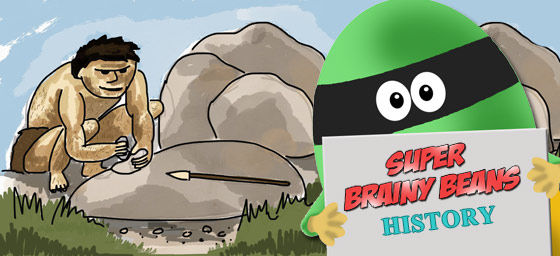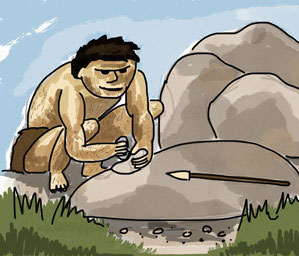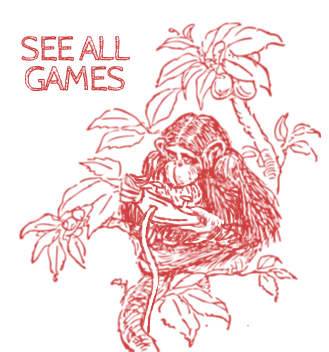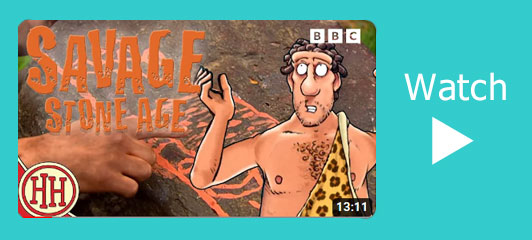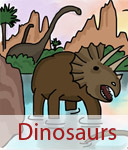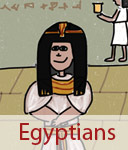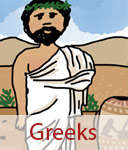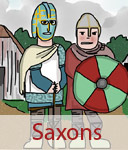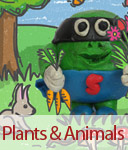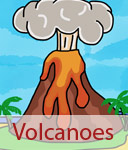Stone Age for kids
Stone Age for kids learning in KS 1 & KS2 at Primary School. Homework help with the history of the Stone Age, cavemen and stone age tools.
Time: 5 million - 10,000 years ago
What was the Stone Age?
The Stone Age was the very earliest period of human history, starting millions of years ago. It was called the Stone Age because people made their tools and weapons out of stone before they learned how to use metals.
Over five million years ago, one of the first groups of early humans lived in Africa. They were called hominids. Hominids looked quite different from us today. They could walk upright like we do, but they were much shorter, had smaller brains, and had ape-like faces.
Hominids used to spend a lot of time living in the trees. Their bodies were adapted to climbing, with long arms and curved fingers and toes that were perfect for gripping branches. But the Earth’s climate began to change, and many forests disappeared. This forced hominids to walk further across open land to search for food. Walking on two legs became much easier than moving on four, and it also gave them a big advantage: standing upright meant they could see further into the distance to spot animals or danger coming their way.
As time went on, hominids slowly developed larger brains, which helped them invent tools, discover fire, and eventually become the humans we are today.
The three periods of Stone Age
The Stone Age lasted for thousands of years, but historians split it into three main periods to help us understand how people’s lives changed over time:

Paleolithic (Old Stone Age)
This was the earliest and longest part of the Stone Age. People lived as hunter-gatherers, which means they hunted wild animals and gathered berries, nuts, and roots to eat. They moved around a lot, following animals and seasons, and lived in caves or simple shelters. During this time, people also created the first cave paintings, which showed animals like bison and mammoths.
The last ice age ended 12,000 years ago. The ice melted as the weather became warmer and huge forests began to grow. The mammoths died out and people hunted smaller animals. Tribes grew crops such as wheat and barley and grew their own food as well as living off hunting animals and fishing. It also marked the end of the Paleolithic period.
Mesolithic (Middle Stone Age)
In this period, people still hunted and gathered food, but they started to use better tools made from smaller, sharper stones called microliths. They also began to build more permanent homes, often near rivers and lakes, where they could fish. Dogs were tamed during this time, becoming the first animals to be domesticated.
Neolithic (New Stone Age)
This was the most advanced stage of the Stone Age. People discovered farming, which changed everything! They grew crops like wheat and barley, kept animals such as sheep and goats, and built permanent villages. They also learned how to make pottery for cooking and storage, and they built impressive stone monuments like Stonehenge.
 Stonehenge - Wiltshire, England
Stonehenge - Wiltshire, EnglandThe most famous prehistoric monument in Britain, built in the Neolithic period. The giant standing stones are arranged in a circle and were probably used for ceremonies.
 Skara Brae - Orkney, Scotland
Skara Brae - Orkney, ScotlandA Stone Age village that is over 5,000 years old. The houses are made of stone, and you can still see beds, shelves, and fireplaces inside.
 Avebury Henge - Wiltshire, England
Avebury Henge - Wiltshire, EnglandThe largest stone circle in Britain. It was built around 4,500 years ago in the Neolithic period and is made up of a huge circular bank and ditch with standing stones inside.
What was life like during the Stone Age?
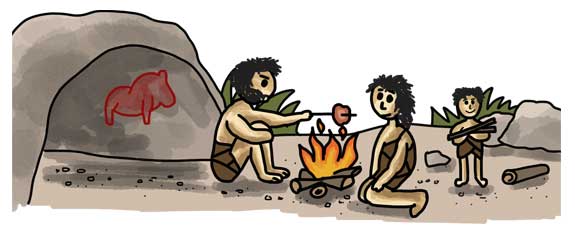
Around 200,000 years ago, Homo erectus evolved into Homo sapiens, which means “wise man” in Latin. These early humans had bigger brains, strong muscular bodies, and a bony ridge above their eyes. One group of early Homo sapiens were the Neanderthals, who lived in Europe and western Asia during the Ice Age. Life was tough, but the Neanderthals were clever and resourceful.
Homes
Because the Ice Age was so cold, the Neanderthals often sheltered in caves to keep warm. When caves weren’t available, they built simple huts out of wooden branches, stones, and animal skins. These shelters helped protect them from icy winds and wild animals.
Clothes and jewellery
Neanderthals wore clothes made from animal skins, stitched together with bone needles. These furs kept them warm during freezing winters. Some people even decorated themselves with necklaces made from shells, animal teeth, and bones — some of the very first examples of jewellery in history!
Food and hunting
Food was hard to find during the Ice Age. Neanderthals ate plants when they could, but they mostly relied on meat. They hunted animals like reindeer and horses, sometimes using fire to scare herds over cliffs. Then they would collect the meat at the bottom. Mammoths and woolly rhinos were much more dangerous, so they avoided getting too close.
Religion and beliefs
Neanderthals were the first people we know of to bury their dead. They dug graves using wooden spears and placed the body inside. Sometimes they added tools, animal horns, or flowers because they believed in an afterlife — a next world where the dead might need these things. This shows they had a spiritual side and cared deeply for their families.
Stone Age children
Children in the Stone Age didn’t go to school like today. Instead, they learned important survival skills from their parents, such as hunting, gathering plants, making tools, and sewing clothes. Young children probably collected firewood and berries, while older ones practiced with small spears until they were strong enough to join hunting trips.
Language
It is believed that the Neanderthals were the first humans to use simple spoken words, along with hand signals. This helped them organise hunts and warn each other of danger.
When were stone tools first used?
Around two and a half million years ago, a new species evolved (changed into something new) from the Hominids called Homo habilis, which means “handy man.” They had bigger brains and were more skilled than earlier humans. One of the cleverest things they did was make their own tools.
They used thin flakes of stone for cutting and larger stones for smashing hard objects like nuts or bones. Long, thin stones called hammerstones were used to chip off sharp flakes from bigger rocks. Even wooden sticks could be sharpened into points, which were useful for digging up roots to eat.
Tools used for hunting
Early humans could sharpen stone into spear tips and attach them to wooden sticks. These spears were used for hunting animals from a distance, which made hunting safer. Small, sharp flakes could cut meat into pieces, and stone knives helped skin animals for their fur, which could be used for clothing. Stone axes and heavy clubs were powerful tools for protection. If wild animals attacked, these weapons gave early humans a chance to fight back. Spears and bows (developed later) allowed them to hunt larger animals like mammoths or deer.
Tools were also used for scraping hides to make clothes, chopping wood for fires, cracking bones to get to marrow, and even making other tools.
Because Homo habilis and later humans ate more meat, they didn’t need to stay only where plants and fruits grew. This gave them more freedom to travel further, explore new lands, and survive in different environments. Eating meat also gave them more energy and helped their brains grow bigger, making them even smarter.
 Kidzfeed - Stone Age
Kidzfeed - Stone AgeStonge Age facts for kids. Learn all about Stone Age.
 Kiddle - Stone Age Facts for kids
Kiddle - Stone Age Facts for kidsStonge Age facts for kids. The Stone Age was an ancient time when people made tools from stone.
When was fire discovered?
Around one million years ago, Hominids evolved again into Homo erectus, which means “upright man” in Latin. Homo erectus is believed to be the first human species to discover and control fire. At first, they probably didn’t know how to make fire themselves, so they waited for lightning to strike and set grass or trees on fire. They would then use branches to carry and transfer the flames.
How fire changed their lives:
- Cooking food: They discovered that meat tasted better and was easier to chew when it was cooked. This meant their teeth and jaws gradually became smaller, as they didn’t need to rip and chew raw meat as much. Eating cooked food also gave them more energy, which helped their brains grow bigger and their bodies taller and stronger.
- Making tools: Fire could heat stones, making them easier to shape into sharper tools.
- Safety and warmth: Flames could scare away dangerous animals and keep people warm in cold weather.
- Light at night: Until then, humans could only be active in daylight. With fire, they could stay awake after dark, telling stories, making tools, or working together as a group.
As time went on, Homo erectus spread far beyond Africa, travelling into Asia and Europe, to places such as China, France, and Spain. As the population grew, they had to move further to search for food, which led them to explore and settle in new lands.
How old are the oldest cave paintings?
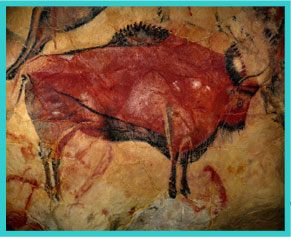 The oldest known cave paintings are around 35,000 years old. Early humans made paint by grinding up soft rocks, minerals, or even charcoal into a fine powder, then mixing it with water, animal fat, or saliva to make a paste. They used their fingers, animal hair brushes, or pieces of animal skin to spread the paint onto the walls.
The oldest known cave paintings are around 35,000 years old. Early humans made paint by grinding up soft rocks, minerals, or even charcoal into a fine powder, then mixing it with water, animal fat, or saliva to make a paste. They used their fingers, animal hair brushes, or pieces of animal skin to spread the paint onto the walls.
Most of the paintings showed animals such as bison, deer, horses, and mammoths — creatures that were important to them for hunting and survival. Some caves even include stencils of human hands, made by blowing paint around a hand pressed against the wall.
No one knows for sure why these paintings were created. They may have been used for ceremonies, to bring luck in hunting, or simply to tell stories. The caves where they painted often went deep underground, meaning the artists had to crawl in with torches to light their way.
The end of the Stone Age
By the end of the Stone Age, people discovered farming. Instead of relying only on hunting and gathering, they could grow crops like wheat and barley and keep domesticated animals such as sheep, goats, and cattle. This meant they could settle in one place and build villages instead of moving all the time.
People also began to experiment with metals, like copper and later bronze. Metal tools were stronger than stone, making farming, building, and crafting much easier. With farming, permanent homes, and metal tools, humans could produce more food, protect themselves better, and start developing the first communities — marking the end of the Stone Age and the beginning of the Bronze Age.

